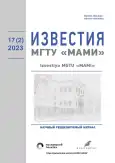Математическая модель алгоритма распределения момента по осям электромобиля с двухмоторной схемой
- Авторы: Заватский А.М.1, Дебелов В.В.1, Малышев А.Н.1, Келлер А.В.1
-
Учреждения:
- Центральный научно-исследовательский автомобильный и автомоторный институт "НАМИ"
- Выпуск: Том 17, № 2 (2023)
- Страницы: 187-194
- Раздел: Электротехнические комплексы и системы
- URL: https://journals.rcsi.science/2074-0530/article/view/253975
- DOI: https://doi.org/10.17816/2074-0530-123092
- ID: 253975
Цитировать
Полный текст
Аннотация
Обоснование. Развитие электрических и гибридных автомобилей невозможно без создания схем, при которых крутящий момент генерируется электромоторами независимо на переднюю и заднюю оси или на каждом колесе и достигается наилучшая динамика. Разработка функции распределения момента по осям или колесам автомобиля является актуальной технической задачей.
Цель работы ― создание математической модели распределения запрашиваемого водителем момента на передний и задний электромотор с целью содействия системе курсовой устойчивости и противодействию пробуксовке колес при движении в повороте на грани сноса/заноса или движении по поверхностям с низким или переменным коэффициентом сцепления.
Материалы и методы. Модель алгоритма реализована в среде MATLAB/Simulink, протестирована в режиме model-in-the-loop на имитационной модели, разработанной в среде LMS Simcenter Amesim, протестирована в режиме hardware-in-the-loop на машине реального времени LabCar (ETAS GmbH) и испытана в составе автомобиля.
Результаты. Функция, основанная на вышеописанных методах, реализована в MATLAB/Simulink. Выполнено тестирование в режиме симуляции на имитационной модели, разработанной в Simcenter Amesim и определены первичные значения калибровочных параметров. Выполнено внедрение функции в структуру ПО прототипа и компиляция исполняемого кода С-кода для мастер-файла, загружаемого в блок управления. Выполнено тестирование в составе блока управления на стенде реального времени LabCar. После устранения выявленных на предыдущих этапах тестирования недочетов, выполнены калибровки и испытания в составе автомобиля, которые показали эффективность описанной модели распределения момента.
Заключение. Практическая ценность исследования заключается в возможности использования предложенных законов управления для разработки систем распределения момента по осям или колесам автомобиля современных транспортных средств.
Полный текст
Открыть статью на сайте журналаОб авторах
Александр Михайлович Заватский
Центральный научно-исследовательский автомобильный и автомоторный институт "НАМИ"
Автор, ответственный за переписку.
Email: Alex7061@yandex.ru
ORCID iD: 0000-0003-0616-1350
SPIN-код: 9509-1069
инженер-конструктор отдела калибровочных работ гибридных транспортных средств
Россия, 125438, Москва, ул. Автомоторная, д. 2Владимир Валентинович Дебелов
Центральный научно-исследовательский автомобильный и автомоторный институт "НАМИ"
Email: vladimir.debelov@nami.ru
ORCID iD: 0000-0001-6050-0419
SPIN-код: 8701-7410
Scopus Author ID: 57209468691
кандидат технических наук, заведующий отделом технологии программного обеспечения
Россия, 125438, Москва, ул. Автомоторная, д. 2Андрей Николаевич Малышев
Центральный научно-исследовательский автомобильный и автомоторный институт "НАМИ"
Email: andrey.malyshev@nami.ru
ORCID iD: 0000-0003-0233-0348
SPIN-код: 6196-3162
заведующий отделом калибровочных работ гибридных СУ и ТС
Россия, 125438, Москва, ул. Автомоторная, д. 2Андрей Владимирович Келлер
Центральный научно-исследовательский автомобильный и автомоторный институт "НАМИ"
Email: andrey.keller@nami.ru
ORCID iD: 0000-0003-4183-9489
SPIN-код: 4622-5727
профессор, доктор технических наук, и.о. заместителя директора
Россия, 125438, Москва, ул. Автомоторная, д. 2Список литературы
- Мировая статистика-2021: электромобили и подзаряжаемые гибриды. Autoreview.ru [internet] дата обращения: 15.12.2022. Режим доступа: https://autoreview.ru/news/mirovaya-statistika-2021-elektromobili-i-podzaryazhaemye-gibridy
- Ларин В.В. Теория движения полноприводных колесных машин: учебник. Москва: МГТУ им. Н.Э. Баумана, 2010.
- Антонян А.А. Повышение устойчивости и управляемости автомобилей колесной формулой 4х4 путем перераспределения подводимых к колесам вращающих моментов. дисс. канд. техн. наук. М., 2021.
- Patent US № 6598721 / 21.05.2019. Michelis A., Ravier C., Moulaire P. Understeer and oversteer detector for a motor vehicle.
- Agliullin T., Ivanov V., Ricciardi V., et al. Torque Vectoring Control on Ice for Electric Vehicleswith Individually Actuated Wheels // Conference: The 26th IAVSD Symposium on Dynamics of Vehicles on Roads and Tracks. Gothenburg, 2019.
- Грачев Е.В., Дебелов В.В., Ендачев Д.В., и др. Разработка концепции управления распределением крутящего момента ведущих колес электромобилей с индивидуальным приводом ведущих колес //Интеллектуальные транспортные системы. Сборник трудов Международного автомобильного научного форума МАНФ-2017. М.: НАМИ, 2017. С. 257-267.
- Дебелов В.В. Системы управления движением транспортного средства. Уч. пособие. М.: Изд-во ФГУП «НАМИ», 2021.
Дополнительные файлы
















